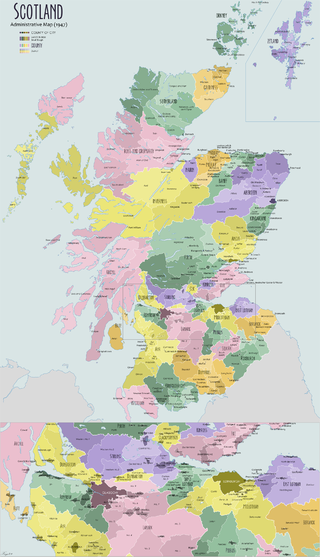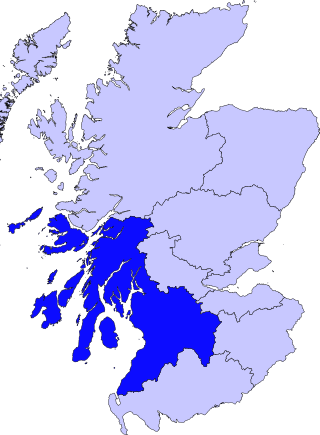Area councils
Each area established by the Act was to be governed by an elected council. The council's title was simply the name of the area followed by the word "Council": Argyll and Bute Council, Aberdeen City Council and so on. Each area was divided into wards with each ward returning a single councillor. The councillors were required to elect a convener, and could choose to elect a deputy convener. In the four city areas (Aberdeen, Dundee, Edinburgh and Glasgow) the convener's title was to be Lord Provost. In the other council areas the convener was to be "known by such title as the council may determine", other than Lord Provost. In 1998 sixteen councils were using the title "provost", the remaining twelve having conveners. [5]
Area councils were obliged to make a draft decentralisation scheme by 1 April 1997. The scheme could provide for:
- The holding of meetings of the council (or any committee or sub-committee) at particular places within the council area
- The establishment of committees for particular areas and the delegation to them of specified functions
- The location of council offices within the area
- The provision of facilities for accessing advice on council services at particular places within the council area
The plan was to include dates at which the various proposals were to be carried out. Having made the draft plan there was to be an eight-week period in which the area council was to consult with the relevant community councils and invite the public to make observations. The decentralisation scheme could then be adopted in original or modified form.

Lanarkshire, also called the County of Lanark, is a historic county, lieutenancy area and registration county in the Central Lowlands of Scotland. The county is no longer used for local government purposes, but gives its name to the two modern council areas of North Lanarkshire and South Lanarkshire.

Local government in Scotland comprises thirty-two local authorities, commonly referred to as councils. Each council provides public services, including education, social care, waste management, libraries and planning. Councils receive the majority of their funding from the Scottish Government, but operate independently and are accountable to their local electorates. Councils raise additional income via the Council Tax, a locally variable domestic property tax, and Business rates, a non-domestic property tax.

Dunbartonshire or the County of Dumbarton is a historic county, lieutenancy area and registration county in the west central Lowlands of Scotland lying to the north of the River Clyde. Dunbartonshire borders Perthshire to the north, Stirlingshire to the east, Lanarkshire and Renfrewshire to the south, and Argyllshire to the west.

The shires of Scotland, or counties of Scotland, are historic subdivisions of Scotland established in the Middle Ages and used as administrative divisions until 1975. Originally established for judicial purposes, from the 17th century they started to be used for local administration purposes as well. The areas used for judicial functions (sheriffdoms) came to diverge from the shires, which ceased to be used for local government purposes after 1975 under the Local Government (Scotland) Act 1973.

Lieutenancy areas, officially counties and areas for the purposes of the lieutenancies, are the separate areas of the United Kingdom appointed to a lord-lieutenant – a representative of the British monarch. In many cases they have similar demarcation and naming to, but are not necessarily coterminate with, the counties of the United Kingdom.

Strathclyde was one of nine former local government regions of Scotland created in 1975 by the Local Government (Scotland) Act 1973 and abolished in 1996 by the Local Government etc. (Scotland) Act 1994. The Strathclyde region had 19 districts. The region was named after the early medieval Kingdom of Strathclyde centred on Govan, but covered a broader geographic area than its namesake.

The Central Belt of Scotland is the area of highest population density within Scotland. Depending on the definition used, it has a population of between 2.4 and 4.2 million, including multiple Scottish cities; Greater Glasgow, Ayrshire, Falkirk, Edinburgh, Lothian and Fife.

Renfrewshire or the County of Renfrew is a historic county, registration county and lieutenancy area in the west central Lowlands of Scotland. The lieutenancy area covers the three modern council areas of Inverclyde, Renfrewshire and East Renfrewshire, and this area is occasionally termed Greater Renfrewshire to distinguish it from the modern council area called Renfrewshire. The historic county additionally included territory on the south-western edge of Glasgow which was gradually transferred to the administrative area of the city as it grew.
Community Health Partnerships, known as CHPs were subdivisions of Health Boards in Scotland, from 2005 to 2015, after which their functions were fully taken over by Health and Social Care Partnerships in April 2015.
Scouting in Scotland is largely represented by Scouts Scotland, a registered Scottish Charity No. SC017511 that is affiliated to the Scout Association of the United Kingdom. The Baden-Powell Scouts' Association also has a presence in Scotland.

The 2012 Scottish local elections were held on 3 May 2012 in all 32 local authorities. The Scottish National Party (SNP) overtook Labour to win the highest share of the vote, and retained and strengthened its position as the party with most councillors. Labour also made gains, while the Liberal Democrats experienced meltdown, losing over half their seats and falling behind the Conservatives. For the first time since the introduction of the Single Transferable Vote system, the SNP won majority control of 2 councils, from no overall control. Labour also won majority control of 2 councils from no overall control, while retaining majority control over 2 councils.

The 2003 Scottish local elections were held on 1 May 2003, the same day as Scottish Parliament elections and local elections in parts of England. All 32 Scottish councils had all their seats up for election – all Scottish councils are unitary authorities.
This is a list of listed buildings in Scotland. The list is split out by council area.
A sheriffdom is a judicial district of Scotland. Originally identical to the Shires of Scotland, from the eighteenth century many counties were grouped to form "sheriffdoms".
Health and Social Care Partnerships, (HSCPs) are organisations formed to integrate services provided by Health Boards and Councils in Scotland. Each partnership is jointly run by the NHS and local authority. There are 31 HSCPs across Scotland. These are statutory bodies, which took over responsibilities from Community Health Partnerships. They are responsible for £8.5 billion of funding for local services.

The 1999 elections to Argyll and Bute Council were held on the 6 May 1999 and were the second for the unitary authority, which was created under the Local Government etc (Scotland) Act 1994 and replaced the previous two-tier system of local government under Strathclyde Regional Council and Dumbarton and Argyll & Bute District Councils. It was held on the same day as the first Scottish Parliament election and resulted in no change to the administration of the council - independent control.
This page is based on this
Wikipedia article Text is available under the
CC BY-SA 4.0 license; additional terms may apply.
Images, videos and audio are available under their respective licenses.











